Introduction to B2B Sales Funnel
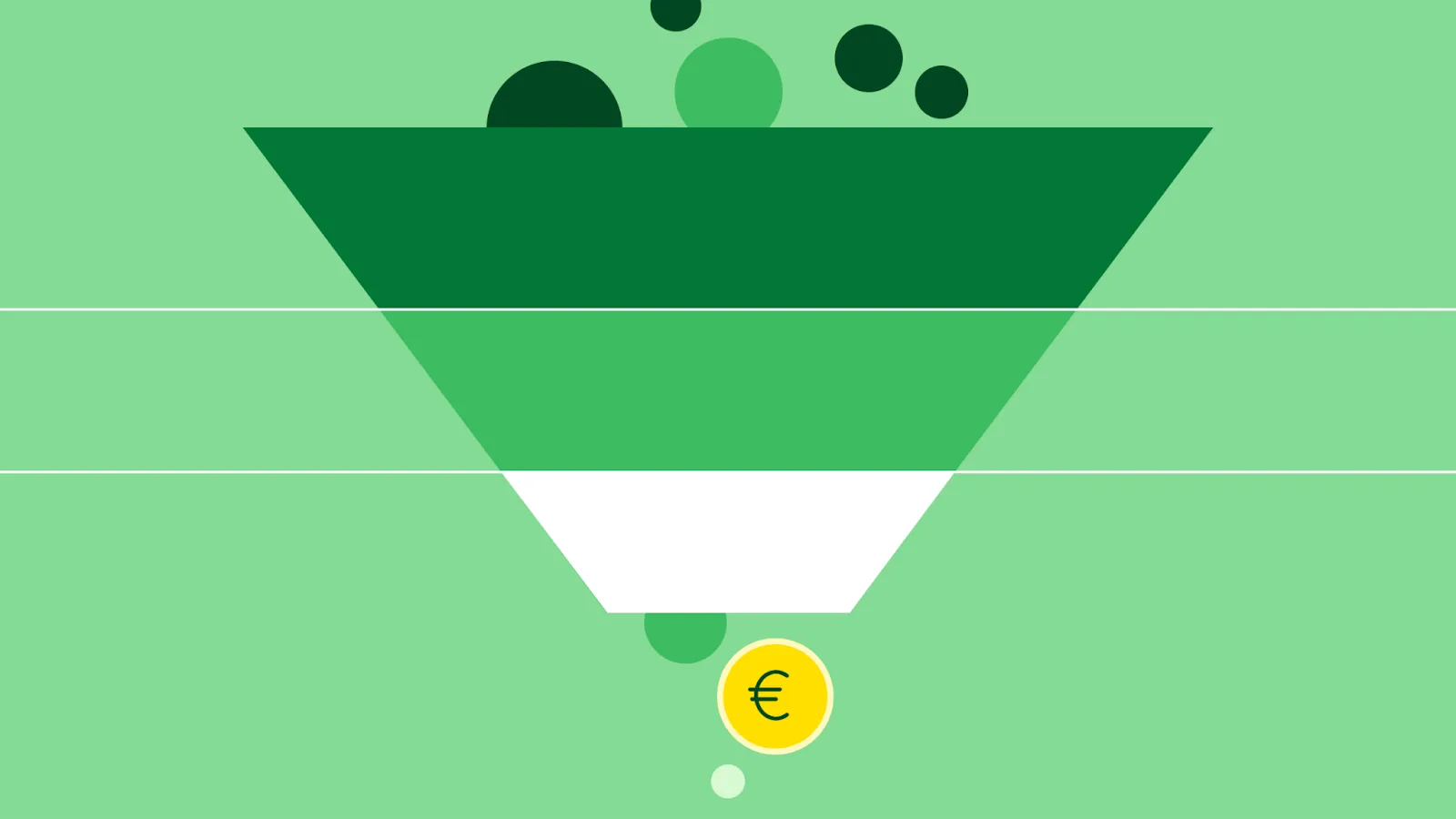
What is a B2B Sales Funnel
A B2B (Business-to-Business) sales funnel is a strategic model designed to guide potential business customers through the journey from initial awareness to the final purchase decision.
Here's a concise breakdown of its elements and purposes:
- Primary Objective: The funnel's main aim is to convert leads into customers by nurturing them through various stages. It effectively transitions a potential lead from knowing about the product to making a purchase.
Understanding the buying process helps businesses tailor their approach at each funnel stage to match the prospect’s decision-making journey.
- Adherence to AIDA: The funnel generally follows the AIDA model, which stands for Awareness, Interest, Desire, and Action. Each stage is critical in moving the customer closer to a sale.
- Optimization and Testing: Optimizing a B2B sales funnel can be a prolonged process. It typically requires substantial traffic to facilitate effective A/B testing. Businesses with the necessary volume of traffic and testing tools should engage in continuous optimization efforts.
- Traffic and Conversion Rate Optimization (CRO): For businesses with less traffic, identifying and repairing breaks in the funnel is crucial. This could involve fixing faulty forms, broken links, or filling missing stages in the user journey. Applying CRO best practices that don't rely on heavy traffic can also be beneficial.
- Strategic Influence: The strategy within a B2B sales funnel involves influencing prospects' decisions favorably to increase the conversion rate. This includes employing tactics that tilt decision-making towards purchasing.
Statistics and Observations:
- Conversion Rates: Typically, only about 4% of visitors to B2B websites make a purchase, highlighting the importance of effective funnel optimization.
- Length of Sales Cycle: The B2B sales cycle often lasts several months, as decisions usually require approval from multiple levels of an organization.
- Impact of Optimization: Regular funnel analysis and adjustments can lead to an increase in conversion rates by up to 20%, depending on the industry and funnel efficiency.
A well-structured B2B sales funnel not only guides a potential customer through their purchasing journey but also serves as a critical tool for businesses. To maximize the return on investment (ROI) strategically nurture leads and optimize various stages of the customer acquisition process.
Why Do You Need a Sales Funnel in Your B2B Journey
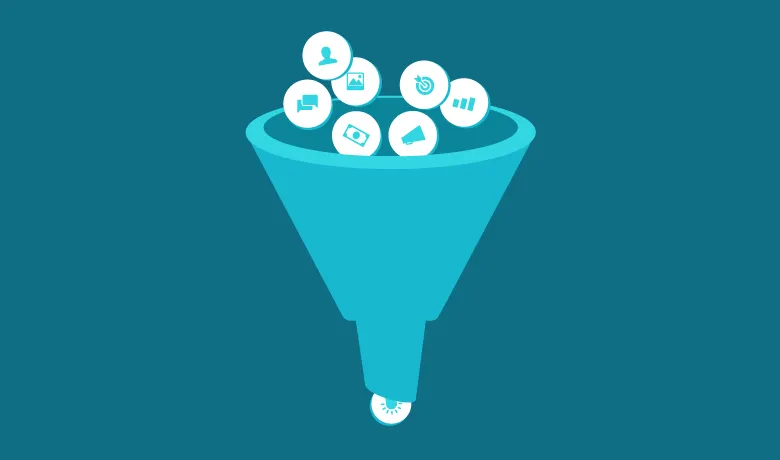
Having a sales funnel in your B2B journey is essential for several compelling reasons:
- Streamlined Lead Management: A sales funnel provides a structured approach for managing leads at every stage of their journey. It helps in categorizing prospects based on their readiness to buy and ensures that each lead is nurtured according to their specific needs and timeline.
For a B2B sales funnel to be effective, sales and marketing teams must work together to align messaging and ensure a smooth lead transition.
- Increased Efficiency: By having a clear roadmap of the buyer’s journey, companies can allocate resources more efficiently. Marketing efforts can be targeted toward the right group at the right time, minimizing wasted effort and maximizing the impact of sales and marketing activities.
- Improved Conversion Rates: A well-defined sales funnel aids in improving conversion rates by systematically moving leads from awareness to purchase. Each stage of the funnel is designed to push the lead closer to making a buying decision through tailored content, communication, and engagement strategies.
- Better Tracking and Metrics: With a sales funnel, businesses can track the effectiveness of their sales and marketing tactics at each stage. This data allows for detailed analytics on where leads drop off, which strategies are working, and how the overall process can be optimized for better results.
📊 Track every lead! Use Alore’s analytics dashboard to monitor opens, replies, and conversions. Try it free!
- Predictable Revenue Generation: A structured sales funnel contributes to more predictable sales outcomes and revenue generation. By understanding where leads are in the funnel, businesses can forecast sales and revenue more accurately, aiding in strategic planning and financial stability.
- Enhanced Customer Experience: The funnel provides a systematic approach to addressing customer needs and concerns throughout their buying journey. This ensures a smoother, more engaging experience for the customer, which can lead to higher satisfaction and loyalty rates. Mapping out the customer journey ensures that each funnel stage is aligned with buyer expectations and behaviors.
- Scalability: As businesses grow, a defined sales funnel allows for scalability. It offers a repeatable, systematic approach to handling increasing numbers of leads without sacrificing the quality of interactions and engagement with potential customers.
B2B vs B2C sales funnel
A marketing funnel captures and nurtures leads before handing them over to sales, ensuring a structured approach to customer acquisition.
Stages with B2B Sales Funnel
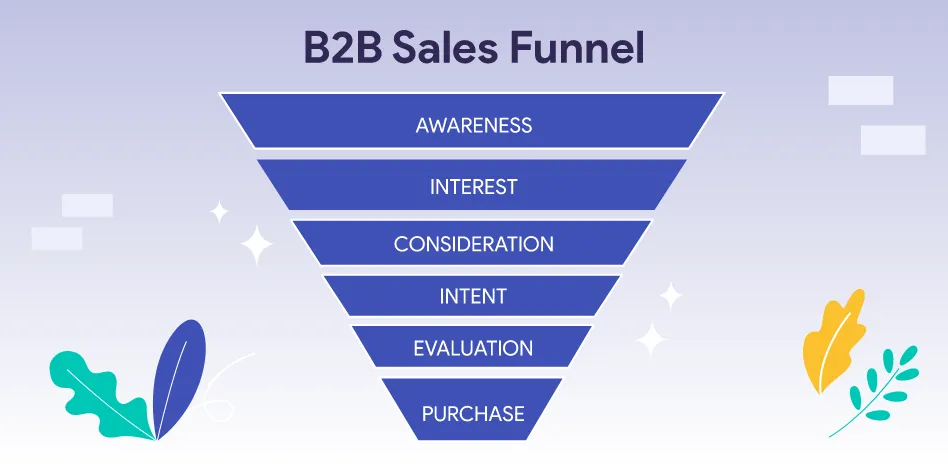
The B2B sales funnel encompasses several distinct stages, each designed to move a prospect closer to becoming a customer.
Understanding and optimizing these stages are crucial for effective sales strategy implementation in a business environment. Each key stage in the B2B sales funnel plays a role in nurturing leads and driving conversions.
Awareness
The Awareness stage is where potential customers first become acquainted with your brand or product. The goal here is to stand out in a crowded market and capture the interest of your target audience.
A well-structured sales pipeline ensures that leads move smoothly through each stage of the funnel without friction.
1. Content Marketing
Implement a robust content marketing strategy that includes informative blog posts, whitepapers, and industry reports.
For example, a tech company might release a whitepaper on the latest trends in cybersecurity, helping to establish thought leadership.
Companies that excel in lead nurturing generate 50% more sales-ready leads at a 33% lower cost.
2. SEO and Online Presence
Optimize your website and content for search engines to ensure visibility when potential customers are searching for solutions you offer.
A B2B software provider might target high-volume keywords that potential customers use when looking for similar software solutions.
4. Social Media Engagement
Use platforms like LinkedIn to share content, engage in discussions, and increase your brand visibility.
LinkedIn is responsible for 80% of B2B leads from social media.
Interest Stage
In the interest stage of the B2B sales funnel, your goal is to deepen the engagement initiated during the awareness stage.
This involves educating potential clients about how your products or services can solve specific problems or improve their business operations.
By providing valuable content, businesses can engage prospective customers and guide them toward making informed purchase decisions.
1. Educational Content
Provide detailed whitepapers, e-books, and webinars that address common industry challenges and showcase your expertise.
According to Content Marketing Institute, 51% of B2B marketers prioritize creating visual assets as part of their content marketing strategies, as they are crucial in making complex information easier to understand.
2. Personalized Email Campaigns
Segment your email lists based on the interest shown during initial engagements to send more targeted content.
Statistics show that segmented email campaigns drive a 760% increase in revenue.
3. Engagement through Social Proof
Share testimonials and case studies that relate to the prospect's industry. B2B buyers are more likely to engage further after seeing credible testimonials that highlight the effectiveness of your solutions.
Consideration
During the Consideration stage, potential clients evaluate your offerings against their needs and other competitors.
They delve deeper into what your products or services can provide and whether these align with their requirements.
1. Educational Content
Provide more detailed content that addresses specific industry issues or showcases the functionality of your products. Webinars, detailed guides, and spec sheets are excellent tools for this.
Hosting a webinar on how your software can integrate seamlessly with existing systems, demonstrating both ease of use and efficiency.
2. Case Studies and Testimonials
Strong case studies and testimonials help convince prospects by providing real-world success stories and credibility.
Share success stories and testimonials from satisfied clients. These are powerful because they offer real-world proof of your product’s effectiveness.
Case studies are the top content form used by marketers to influence B2B buying decisions.
3. Product Demonstrations
Offer free trials or live demos that allow prospects to experience your product first-hand. A cloud services provider might offer a 30-day free trial, giving potential customers the chance to test the service’s impact on their operations.
Communicating a clear unique value proposition helps differentiate a business from competitors and builds trust with prospects.
4. Interactive Tools
Use tools like ROI calculators or product configurators that help potential customers understand the value your solution can add to their business.
An enterprise software company provides an ROI calculator on its website to help CFOs calculate potential savings over time.
Intent Stage
At the intent stage, prospects are considering your offering seriously and comparing it with competitors.
Here, the focus shifts to nurturing that intent into a concrete buying decision by highlighting unique selling propositions and value.
Tailored Demonstrations
Offer live demos or trial versions of your product tailored to the specific needs of the prospect.
For instance, a software company might provide a free, customized demo that shows how their tool integrates with the prospect’s existing systems.
In-depth Consultations
Arrange consultative sessions with key decision-makers to discuss their specific needs and how your solution can meet them. These sessions help in addressing any reservations and reinforcing the product’s value proposition.
A skilled sales rep understands customer pain points and tailors their approach to guide prospects through the funnel effectively.
Advanced Content Offers
Provide advanced content such as ROI calculators, product comparison guides, or industry reports that support the prospect's decision-making process.
Such tools can help demonstrate potential cost savings or productivity gains from your solution.
Follow-Up Strategies
Persistent follow-ups are critical at this stage. A study by the National Sales Executive Association found that 80% of sales require five follow-up calls after the meeting, indicating the importance of persistence in closing deals.
Purchase
The Purchase stage is where negotiations are finalized, and decisions are made. At this point, the prospect is ready to buy, but effective techniques are required to ensure the deal is closed.
The final stage of the sales funnel requires strong negotiation skills to close deals and maximize conversion rates.
Customized Proposals
Tailor your proposals to address the specific needs and concerns of each prospect. For instance, if a company knows that their client is concerned about cost-efficiency, they could highlight unique cost-saving features of their product or service.
According to studies, customized proposals can improve conversion rates by up to 35%. Effective Negotiation Tactics
Employ skilled negotiators who are prepared to handle objections and offer solutions that align with both parties' needs.
It's reported that effective negotiation can increase deal closure rates significantly, often by 30% or more.
Final Demonstrations
Provide a final demo or a detailed walkthrough of your product or service, reinforcing the value and effectiveness.
This helps in resolving any last-minute hesitations and is a proven strategy to increase the confidence of the buyer.
Retention
Once the purchase is made, the focus shifts to Retention, which is crucial for maintaining a sustainable business model through repeat sales and referrals.
Post purchase engagement, such as customer support and loyalty programs, ensures client satisfaction and repeat business.
Customer Support and Service
Providing excellent post-sale support can significantly increase customer satisfaction and retention rates.
For example, a tech company might offer 24/7 customer support and dedicated account managers to ensure clients receive timely assistance.
Studies have shown that businesses with robust customer support retain up to 90% of their customers.
Ongoing Engagement
Keep your customers engaged with regular updates about new features, services, or content that adds value to their business.
For instance, sending monthly newsletters that include industry insights, user tips, or success stories can keep your brand relevant and top of mind.
Loyalty Programs and Incentives
Implement loyalty programs or offer incentives for renewals and referrals. These programs are not just for B2C markets; even in B2B scenarios, they can lead to higher retention rates.
For example, offering a discount on the next purchase or upgrade for referring a new client can be an effective strategy.
Requesting Feedback
Regularly solicit feedback to improve your products and services. This not only shows that you value customer input but also helps in making necessary adjustments to better meet their needs.
A feedback loop can lead to product improvements that increase customer satisfaction and loyalty over time.
How to Build a B2B Sales Funnel
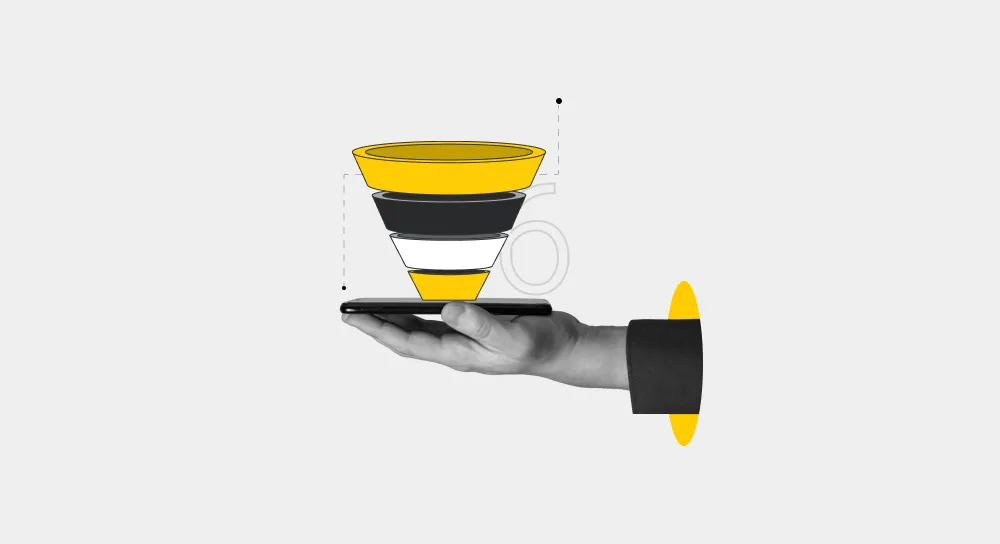
Building a B2B sales funnel involves a series of strategic steps designed to attract and convert new clients while nurturing existing relationships.
An effective sales funnel not only drives conversions but also optimizes engagement and retention strategies for long-term success.
Here's a comprehensive guide on how to construct an effective B2B sales funnel:
1. Define Your Target Audience
Understanding exactly who your business serves is fundamental in crafting any effective marketing and sales strategy.
This step ensures that all subsequent efforts are tailored to the right group of potential clients.
- Market Research: Conduct extensive research to gather insights about industries, company sizes, job roles, and challenges faced by potential clients. For instance, a company selling cloud-based solutions might focus on industries heavily reliant on data management, like healthcare or finance.
- Customer Segmentation: Segment your audience based on factors such as industry, company size, decision-making capacity, and specific needs. For example, different messaging might be used for IT managers in small tech startups compared to those in large enterprises.
- Persona Development: Create detailed buyer personas that represent your typical customers. These should include demographic info, business pain points, preferred communication styles, and buying behavior. For example, "Finance Frank" could be a CFO at mid-sized enterprises who values cost efficiency and regulatory compliance.
2. Attract Prospects
Once you clearly understand your audience, the next step is to attract these potential customers to your business. The goal here is to generate awareness and begin engaging users at the top of the funnel. Marketing teams play a crucial role in lead nurturing by creating educational content and running targeted campaigns.
- Content Marketing: Develop and distribute valuable content that addresses the specific needs and pain points of your target audience. Blogs, whitepapers, and industry reports can establish your brand as a thought leader. According to HubSpot, B2B marketers who use blogs receive 67% more leads than those who do not. A company blog serves as a valuable tool for educating prospects and driving organic traffic to the sales funnel.
- SEO Strategies: Optimize your content and website for search engines to increase visibility. Use keywords that your target audience is likely to search for. A strong SEO strategy can increase organic reach significantly, with marketers reporting as much as a 70% increase in effective lead generation.
- Social Media Marketing: Utilize platforms like LinkedIn, which is particularly effective in B2B contexts. Share content, participate in discussions, and engage with other industry leaders. LinkedIn makes up more than 50% of all social traffic to B2B websites & blogs.
- Paid Advertising: Invest in PPC (pay-per-click) campaigns on platforms relevant to your industry. For example, Google Ads and LinkedIn ads can be tailored very specifically to reach decision-makers within certain industries, job roles, or even specific companies.
- Networking and Events: Attend industry conferences, seminars, and webinars to connect with potential customers. Hosting a booth at an industry event or speaking at a seminar can position your company as an expert and a go-to solution provider in your field.
3. Generate Leads
The lead generation stage is where potential customers' interest is captured, and their contact information is secured for further engagement. This stage is crucial as it fills the funnel with prospective leads who have shown some level of interest in your offerings.
- Lead Magnets: Provide valuable resources such as eBooks, white papers, or industry reports that require prospects to submit their contact information. For instance, a software company might offer a free eBook on "Increasing Productivity with Automation Tools" in exchange for email addresses.
- High-Converting Landing Pages: Design landing pages that are clear, concise, and compelling with a strong call to action (CTA). Including testimonials or client logos on landing pages can increase conversion rates by up to 15%.
- Webinars and Online Workshops: Host webinars that not only educate but also capture leads. For example, a marketing agency could host a webinar on "Latest B2B Marketing Strategies Post-Pandemic" and require registration to attend. Diversifying sales channels, including direct outreach and digital marketing, expands reach and improves lead generation.
🔥 Boost your email outreach! Automate follow-ups, personalize campaigns, and track results with Alore’s Drip Campaigner. Try it now!
4. Nurture Leads
Once leads are generated, the nurturing process begins. This involves educating and building relationships with potential customers, moving them closer to a purchasing decision.
- Segmented Email Campaigns: Use the information gathered during lead capture to segment your email lists. Tailored content can lead to a 760% increase in email revenue from segmented campaigns. Each interaction with a prospect should be designed to smoothly transition them to the next stage of the funnel.
- Educational Content: Continue to provide value through more in-depth articles, how-to guides, and videos. This positions your brand as a trusted advisor in the field.
- Regular Follow-ups: Implement a schedule for regular follow-ups via email or phone to keep your brand at the forefront of leads' minds. Personalized follow-ups are crucial; a study shows that personalized emails deliver 6x higher transaction rates.
5. Convert Leads into Customers
This final stretch of the funnel is where you turn warm leads into paying customers. It's about making the right offer at the right time.
- Personalized Demonstrations or Trials: Offer demos or trials that are tailored to the specific needs and pain points of the lead. For example, a CRM tool might provide a personalized demo that focuses on the lead’s specific industry challenges. Personalized communication and targeted offers help convert potential customers into long-term clients.
📩 Automate your sales! Set up drip campaigns, nurture leads, and convert faster with Alore. Get started now!
- Effective Closing Techniques: Train your sales team in effective closing techniques, such as consultative selling, which focuses on creating value for the lead rather than just selling a product.
- Time-Sensitive Offers: Create urgency with limited-time offers or exclusive packages for prospects who commit within a certain timeframe. For instance, a discount on the annual plan if signed within the week. The ultimate goal of any sales funnel is to convert leads into paying clients and establish long-term relationships.
6. Optimize and Scale
After establishing your sales funnel, the focus should shift to refining the process and preparing for expansion. This stage involves analyzing data, testing different strategies, and scaling successful practices.
- Analytics and KPI Tracking: Use CRM and analytics tools to track key performance indicators (KPIs) like conversion rates, lead time, and customer acquisition cost. For example, a software company may find that their lead-to-customer conversion rate is 10%, which sets a benchmark for improvement.
- A/B Testing: Regularly test different elements of your marketing and sales strategies, such as email marketing campaigns or landing page designs, to determine what works best. An A/B test might show that changing the call-to-action button from “Learn More” to “Schedule a Demo” increases click-through rates by 20%.
- Customer Feedback: Gather and analyze customer feedback to identify areas for improvement. Implementing changes based on customer suggestions can lead to a 15-20% increase in customer satisfaction.
- Scalability Strategies: Look for ways to scale your efforts without compromising quality. This might include automating certain marketing or sales processes, or expanding into new markets or segments.
🚀 Avoid spam folders! Use Alore’s Email Warm-Up to improve deliverability and inbox placement. Start now!
7. Retain and Expand Customer Relationships
Maintaining strong relationships with existing customers and finding opportunities to increase their engagement can lead to higher lifetime value and referrals.
- Customer Success Programs: Implement customer success programs aimed at helping customers achieve their objectives with your product or service. For instance, a cloud services provider might offer regular training sessions to help customers optimize their use of the platform.
- Regular Communication: Maintain a regular communication schedule with newsletters, updates, and customer satisfaction surveys. Regular check-ins not only show you care but also keep you informed about potential issues or further needs.
- Loyalty and Referral Incentives: Create loyalty programs or offer incentives for referrals, which can increase customer retention and attract new clients. A referral program that rewards both the referrer and the new customer can boost referral rates by up to 30%.
- Cross-selling and Upselling: Identify opportunities for cross-selling or upselling based on customer usage patterns and feedback. For example, a company selling business software might offer advanced analytics features as an upsell to customers who have maximized their basic plan.
Strategies for B2B Sales Funnel
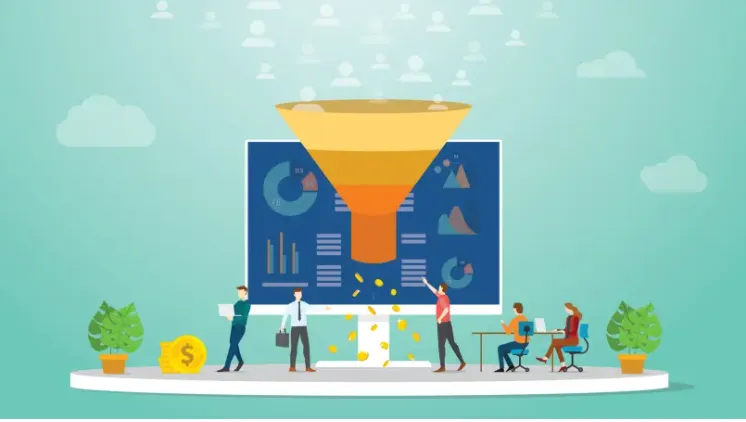
Effective strategies for managing a B2B sales funnel can significantly enhance the efficiency and success of your sales efforts. These strategies should aim to attract, engage, and convert prospects into customers, while also nurturing existing relationships to maximize lifetime value. Here are some key strategies to consider:
1. Targeted Content Marketing
Content marketing is a powerful tool in the B2B sector. It should be designed to address the specific problems and needs of your target audience.
Educational Content: Develop blog posts, whitepapers, e-books, and webinars that educate your audience about industry issues and your solutions.
SEO Strategy: Optimize content for SEO to ensure visibility in search engine results, capturing organic traffic from potential leads who are searching for solutions to their problems.
2. Lead Generation Tactics
The ability to generate high-quality leads is crucial for a successful sales funnel. Identifying potential buyers early in the funnel allows businesses to focus on high-intent leads and improve conversion rates.
High-Value Lead Magnets: Offer valuable resources such as free tools, templates, or industry reports in exchange for contact information. Focusing on qualified leads reduces wasted efforts and ensures that sales teams engage with prospects who have genuine purchase intent.
Landing Pages and CTAs: Use optimized landing pages with clear, compelling calls to action that encourage visitors to take the next step in the sales process.
3. Personalized Email Marketing
Email marketing remains one of the most effective methods for progressing leads through the sales funnel.
Segmented Campaigns: Segment your email list based on user behavior and demographic details to send more personalized and relevant emails.
Automation and Drip Campaigns: Implement email automation to send timely and relevant information to leads at different stages of the funnel.
4. Effective Use of CRM Tools
A robust Customer Relationship Management (CRM) system helps manage and analyze customer interactions throughout the lifecycle.
Lead Scoring: Utilize CRM to score leads based on their interaction with your content and website, helping sales teams prioritize high-potential prospects.
Data Analysis: Analyze data collected in the CRM to identify patterns and insights that can inform future sales and marketing strategies.
5. Account-Based Marketing (ABM)
ABM is an increasingly popular strategy in B2B marketing, focusing on targeting specific high-value accounts rather than broader markets.
Customized Campaigns: Develop bespoke marketing campaigns tailored to the specific needs and characteristics of key accounts.
Cross-Department Collaboration: Align marketing and sales efforts to ensure that messaging is consistent and all interactions are strategically designed to convert each targeted account.
6. Social Selling and Networking
Leveraging professional networks and social platforms can greatly enhance your reach and engagement.
LinkedIn Marketing: Use LinkedIn for publishing articles, joining discussions, and networking with industry leaders.
Community Engagement: Participate in industry forums and networks to build visibility and credibility within your sector.
7. Customer Retention and Upselling
Focus on retaining existing customers through excellent service and identifying opportunities to upsell or cross-sell.
Customer Success Teams: Establish dedicated teams to ensure customers achieve their desired outcomes, enhancing satisfaction and retention.
Feedback Loops: Regularly collect and act on customer feedback to improve products and services.
Concluding Thoughts on B2B Sales Funnel
In conclusion, designing an effective B2B sales funnel requires a meticulous, data-driven approach that encompasses understanding your audience, attracting the right prospects, nurturing leads, and fostering customer relationships. Through strategic implementation at each stage—from awareness and engagement to purchase and retention—you can significantly enhance your sales outcomes. Employ tactics like targeted content marketing, personalized email campaigns, and robust use of CRM tools to move prospects smoothly through the funnel. Remember, the ultimate goal is not just to close a sale, but also to create long-term relationships that promote repeat business and referrals. By continuously analyzing and refining your funnel strategy, you ensure your sales process remains dynamic and responsive to changing market conditions and customer needs. This proactive approach is key to achieving sustained success in the competitive B2B marketplace.

.webp)



.jpg)

.jpg)
